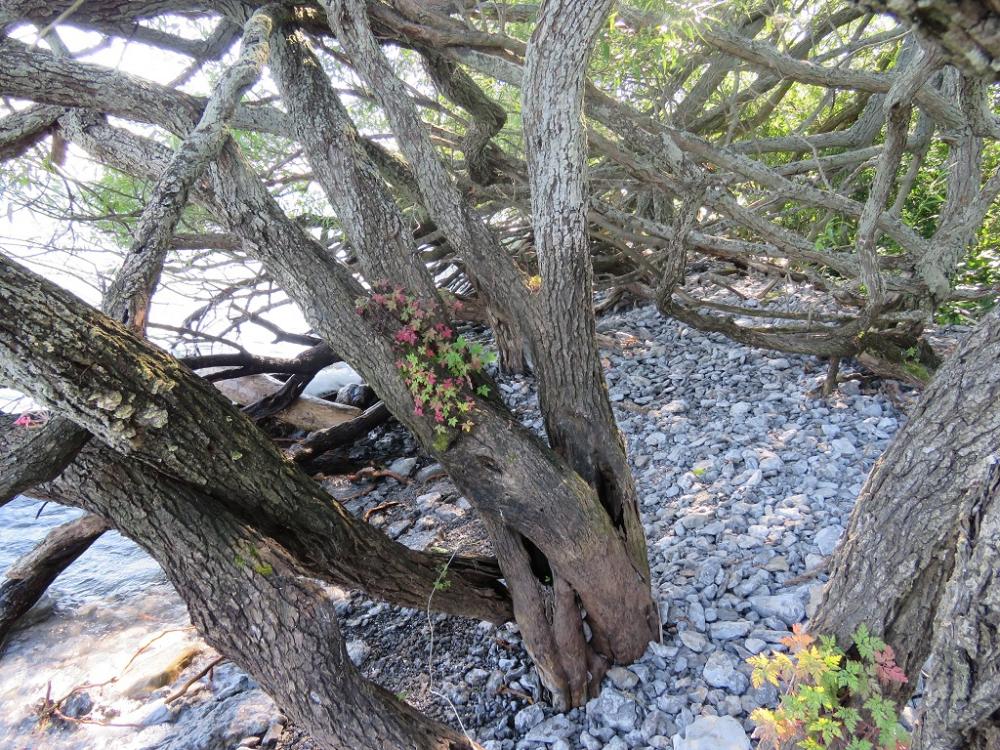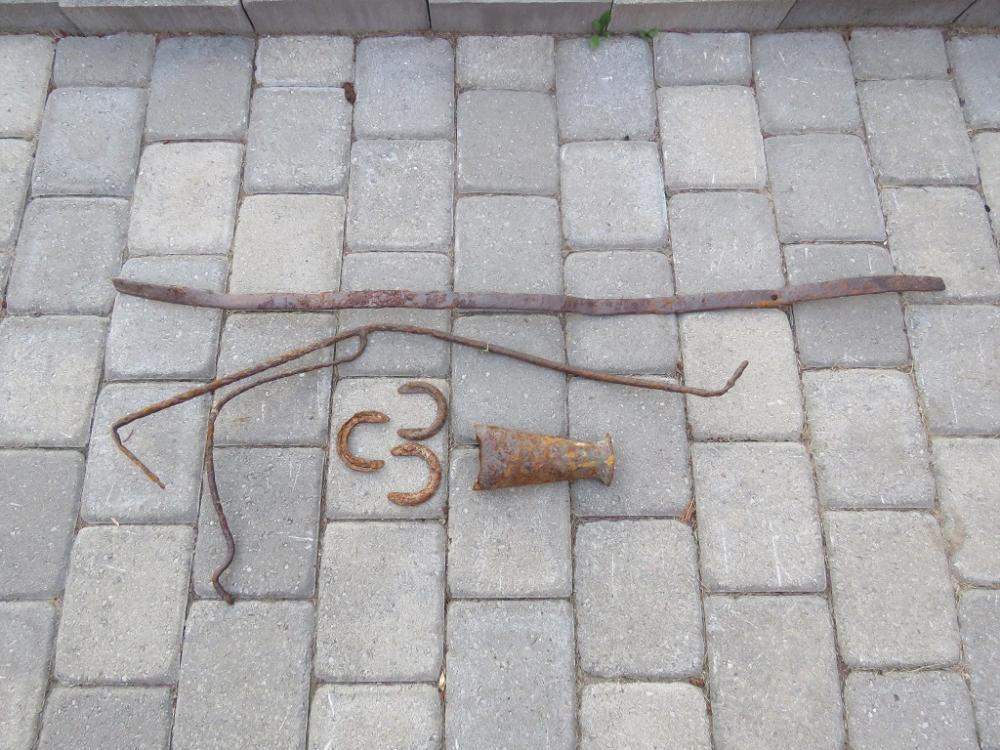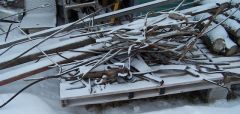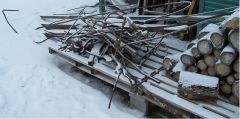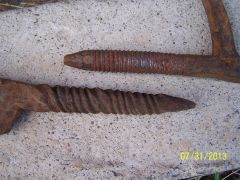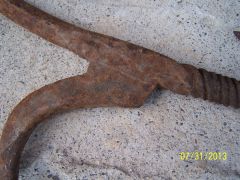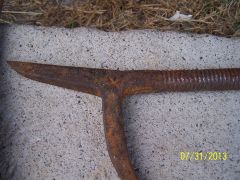
Don Shears
Members-
Posts
122 -
Joined
-
Last visited
Content Type
Profiles
Forums
Articles
Gallery
Downloads
Events
Everything posted by Don Shears
-
Assembled/fabricated a brass spool holder for my spouse's sewing machine. No blacksmithing, just some basic shop skills and time with polish and rags. Designed to hold the over-sized spools of specialty threads she likes to use. Made from odds and sods brass bits I've accumulated over the past decade or so. I also glued a piece of cork gasket sheet on the bottom to protect the table top. Picture on the wood table top has a Canadian one dollar (loonie) coin for scale; the other has the holder at the sewing table sitting on a cutting mat with a 1 inch grid. Total weight is just under 3.2 pounds. Merry Christmas all.
-
My two cents (best guess) on this is a saw set for the teeth of two person cross cut saws. The teeth on those saws are usually about 2" long on a new saw.
-
My NSWAG (Non-Scientific Wild A$$ Guesses) include (tool wise) a reamer for either a cooper or a wheelwright. Or a scraper/cleaning tool for a foundry. For a cooper - to clean up the bung holes on casks. Wheelwright - cleaning up the axle holes in wheel hubs. Foundry - cleaning of large castings with deep recesses. (Think of the wheels on the railroad steam engines, or larger castings for the flywheels on stationary steam engines. I'm more likely wrong then right on this. Don
-
My 2 cents - Weather vane Mast/Support pole (?) The copper plating should tarnish to a nice green. Or use some as a trade item/Iron in the Hat offering at the local BS meeting(s). And just like here, ask those folks for suggestions.
-
Last Sunday my wife and I went for a afternoon drive and a walk on the beach (North shore of Lake Ontario.) With the high water levels this year areas that had 20 to 30 feet of beach can be down to 6, leaving you the choice to either wade or take the obstacle course. Anyways with the heavy wave action on the shore quite a bit of the shore scree has been churned up. Came home with a piece of wrought iron about 42 by 1 1/4 by 1/4 inches. Either a runner from a sled or part of a buggy tire (two visible forge welds and there could be other welds that are not so visible. Also found a brace or bracket? 3 stamped clips and a cone of 1/8 inch sheet. For scale the pavers are roughly 8 1/4 by 6 3/4 inches. I do want to go back, there's about 30 plus feet of 1/2 inch steel cable washed with the remains of a boat dock. Don
-
Both tool are saw sets. I have several of other styles. Both have adjustments for length of the saw tooth and angle. If you take a close look at the cutting teeth of a traditional western wood workers saw you'll see that they lean out slightly past the sides of the blade. This is to prevent the saw blade from binding in the cut. I've never sharpened any of my own saws, just have a idea of the principles. Don
-
In the summer of 2007 I was in Reims, France. Incredible variety of iron work styles all around the central part of the city. This is due to the reconstruction after WWI, where some folks had their homes/property (buildings) rebuilt as they looked before the war, or had (at that time) modern buildings put up to replace the destroyed or too damaged. So the styles range from Medieval to Art Deco. Plus the Notre-Dame de Reims Cathedral is a UN World Heritage site well worth looking at. In Paris, if your into armour, there's the Musée de l'Armée. Lots (and I do mean lots) of suits of armour. Plus ancient arms to very modern. There's also Guédelon Castle in Treigny, France. It's the site of the construction of a 13th century French castle using only techniques known at the time. This castle is the subject of the BBC TV series "Secrets of the Castle." There's also the Maison de l'Outil (House of Tools) in the city of Troyes (about 100 km) south of Reims. I haven't been there, but slightly regret the missed opportunity. Enjoy your trip where ever you decide to go. Don
-
For the most part that's true; but they're great for heavy aircraft maintenance, as part of a group for pulling/installing major panels and floor boards. A couple of the crew starting removal/insertion with screwdrivers followed by others with the speeders. Saves time, wrists, and stripped screw-heads compared to air tools.
-
Realistic Blacksmithing in a Movie - Smoothbore, in response to your question, check out the opening sequence of the Russell Crowe film (1993) "Hammers Over the Anvil." The camera view is primarily shot at about the height of the of the anvil face, and follows a farrier making a horseshoe from bar stock.
-
ianinsa - I had to think a bit about potential uses for a while. I finally remembered the use of a lead bath for tempering blades, springs, chisels and punches. I saw this technique demonstrated over ten years ago by Lloyd Johnston, another smith who lives in my region of Ontario, Canada. Lloyd used a lead bath over his coal forge to temper a replacement spring he had made for a leg vice. It's difficult to maintain a low steady temp over a coal forge to keep the lead from fuming (definitely not healthy), so the electric temperature control is a bonus. The disadvantage of the pot you have is the small overall size and shape of the pot. Since the temperature is a known, as is the mass being tempered, time becomes a more predictable variable. Not an ideal repurposing of the tinning pot, but the best of what I've been coming up with. Cheers. Don
-
Reminds me of a 'tinning' pot used for dip tinning of electronics wiring. A quantity of solder (63/37 lead/tin alloy usually) was melted in the pot. The insulation of circuit connection wires for solder cup connectors. Ends were pre-stripped to the correct amount of exposed conductor (either bare or tinned copper) needed, the end was dipped in liquid rosin flux followed by dipping in the liquid solder. Then the wiring harness was built up. It's an older style of labour intensive assembly technique that's pretty much phased out. Was shown and taught the technique in trade school 30 plus years ago and I've never used since. Don
-
I have a similar style struck tool, they're used for sharpening/re-shaping the cutting bits of pneumatic drills, used in mining/rock quarrying. There was an example included as part of a display in the Royal British Columbia Museum, Victoria B.C. Canada. I do have pictures, but not on file in the laptop I'm currently using.
-
My best guess, a struck tool called a 'cheese fuller.' This definition came out of The Kenneth Lynch Tool Collection Catalog - "...tool is used by the blacksmith for spreading hot metal especially plate. It is similar to a flatter, but has a convex face." Don
-
Spotted this the other day
Don Shears replied to Branstetter's topic in Anvils, Swage Blocks, and Mandrels
From the appearance in the picture; it is a complete bridge anvil with a coating of surface rust. From what I can make out from the photo it appears to have seen some use. Part of the manufacturers name is visible, the 'WELL SUPPLY C...." A rare to see or come by item in my area (South Eastern Ontario.) Thanks for the post. Don -
Colonial Farming Implements
Don Shears replied to Ridgewayforge's topic in Tools, general discussion
Check "THE KENNETH LYNCH TOOL COLLECTION CATALOG" available through the link below; https://docs.google.com/file/d/0B_P1cjplazYgVGFRWEZYa3RRQmc/edit?usp=sharing There are quite a few gardening implements shown along with (very) brief descriptions on their use. An extensive catalog of tools used by many trades - a good resource to help identify that unusual find. Don -
Salvage from Barn Demolition. Pictures of some the material I salvaged (with permission) from a barn demolition. A better write up is give with the first image in the gallery. Don http://www.iforgeiron.com/gallery/image/37996-salvage-1/ http://www.iforgeiron.com/gallery/image/37997-salvage-2/
-
-
Salvaged material from a barn demolition, the long rods are 3/4 inch (19mm) wrought iron silo hoops (reinforcing hoops that go around vertical storage silos - common here on North American farms.) These were from the original wood bodied silo which was replaced by a concrete panel type sometime after WWII. The hoops were thrown into a scrap pile, then re-used as re-bar in concrete work improvements made during the 1960's. Each of the hoops are about 20 feet long (6 meters), they were folded up for ease of transport. Also in the pile are smaller pieces also used to reinforce the concrete, includes wrought iron, mild, and high carbon pieces from old wagons and farm machinery. Whatever was available to use was, I even found a shock absorber!
-
Anachronist58 - my best guess is possibly a feed auger for a plastic (or some other type) of extruder mechanism. Think akin to a meat grinder done grand industrial. Have been lucky lately myself. Last summer a cousin held a work party to remove the original siding from her circa 1900 farmhouse, I came home with about 10 lbs of square cut wrought iron nails. The farmer who owns the lands around my home has been letting me recover scrap metal, including wrought iron, from the demolition of a barn near my home. I got permission from the land owner after the demolition started becoming a fiasco. The Barn went up in two phases, the original and smaller part in the mid to late 1840's and the larger and main part in 1906. The different folks involved in the demo have either blotched it badly, or had worse help. The first fellow to do the initially planned salvage blotched it badly turning about 70% of the recoverable material into broken pieces. On the main section (from 1906) he removed the braces he could reach from the floor, undercut the posts, and then pulled the structure over (in the wrong direction.) None of the pins were removed from the mortise and tenon joints so the majority of the large lumber pieces were damaged. The land owner ordered him off. A second fellow took over to clean up and sell what he could salvage. He was doing okay until a visitor to the site didn't like how things were being done. The visitor hopped into the excavator that was at the site, and in his keen desire to 'help' trashed over 3/4's of the remaining salvageable materials. Very frustrating and depressing to find so much first growth timber, hand hewn turned into splinters at worst, and firewood at best. Lots of northern jack pine, beech, maple and oak beams and boards, fir purlons for the roof, all dry and relatively sound, trashed. From the barn I've recovered about 15 pounds of square cut nails, spikes, and hardware (all wrought iron), an assortment of mild steel rods and spikes. Then from some of the concrete work, used as rebar, 60 plus feet of silo hoops (WI), wagon fittings and wheel tyres (WI), other miscellaneous pieces including horse tack (mixed metals), and old farm machinery and vehicle pieces. Plus there's wiring, piping and other metal items that appear as the clean up progresses. Will take some pictures of the recovered materials to post later. Don Shears
-
I downloaded and had a quick look through of THE KENNETH LYNCH TOOL COLLECTION a little while ago (sourced from a posting on The Armour Archive.) This style looked familiar, a quick look through again found a similar shaped listing (KL 209m Raising Hammer.) The one in your the pictures is larger then those on the collection list. The largest listed in the Lynch Collection is 1.4 pounds, 5.5 inches long, 1.5 inches wide pean, and 0.75 inches thick at the pean. I suspect that this is one of those tool patterns that crosses trades and purposes because it does various jobs so well. As Dogsoldat posted - a bead breaker for tires. I've seen hemostats (surgical clamps) used for holding 2 inch wiring clamps closed while a tech was installing wiring on an aircraft. Did the job and kept the frustration level low. Here's a shortcut to the Google Doc's copy of THE LYNCH TOOL COLLECTION that was posted at The Armour Archive: https://docs.google.com/file/d/0B_P1cjplazYgVGFRWEZYa3RRQmc/edit?usp=sharing Don
-
John M.: I've never tried electrolytic cleaning - it's a suggestion to seriously think about for this item. If I do that I'll certainly post pictures of the results. I'm curious and would appreciate seeing a picture (or more) of that point. I'm usually pretty good at picking out wrought iron, and at finding the forge welds. I was back at the same scrap yard today and picked up a piece of wrought iron 1/2 inch round by 7 ft. Forge welded eye at one end (very big clue as to the material) and threaded at the other. Corrosion is revealing a very fine grain structure. Also stopped at a garage sale on a whim, 3 heavy chisels (1 inch octagonal stock) all about 12 inches long for $3.00. Don
-
I picked up a couple of points for loggers boom poles (similar to pikes.) Used for helping to move logs in booming grounds (gathering logs into rafts), while 'driving' them to the mill, and moving the logs into the mill for processing. The two points are now roughly 1/2 inch sq. material, obviously two different styles, and one has a makers mark. The threading on the smaller point was cut with commercial dies. The larger points threads were made by twisting the stock. The transition between the point and hook on the larger point is quite interesting, but doesn't look like a weld to me. '?do=embed' frameborder='0' data-embedContent>> '?do=embed' frameborder='0' data-embedContent>> '?do=embed' frameborder='0' data-embedContent>> '?do=embed' frameborder='0' data-embedContent>> I'd like to try copying these one day as a demonstration piece. My apologies, I forgot to post thumbnails. Don
-
The mounting threads used on two different loggers pole points. Both points are about 1/2 inch sq. stock. The upper has threads made by using a commercial die set. The lower was threaded by twisting the stock. Mounting these points in poles required drilling a pilot hole in the pole end, mounting a ferrule to reinforce the pole end, then threading the point into the hole.
© Don Shears 31 July 2013
-
-
.thumb.jpg.c551fc9b33489765cf1e658f64dd6e0a.jpg)
.thumb.jpg.eb216a156e14871b9df0a9d380516fbf.jpg)
